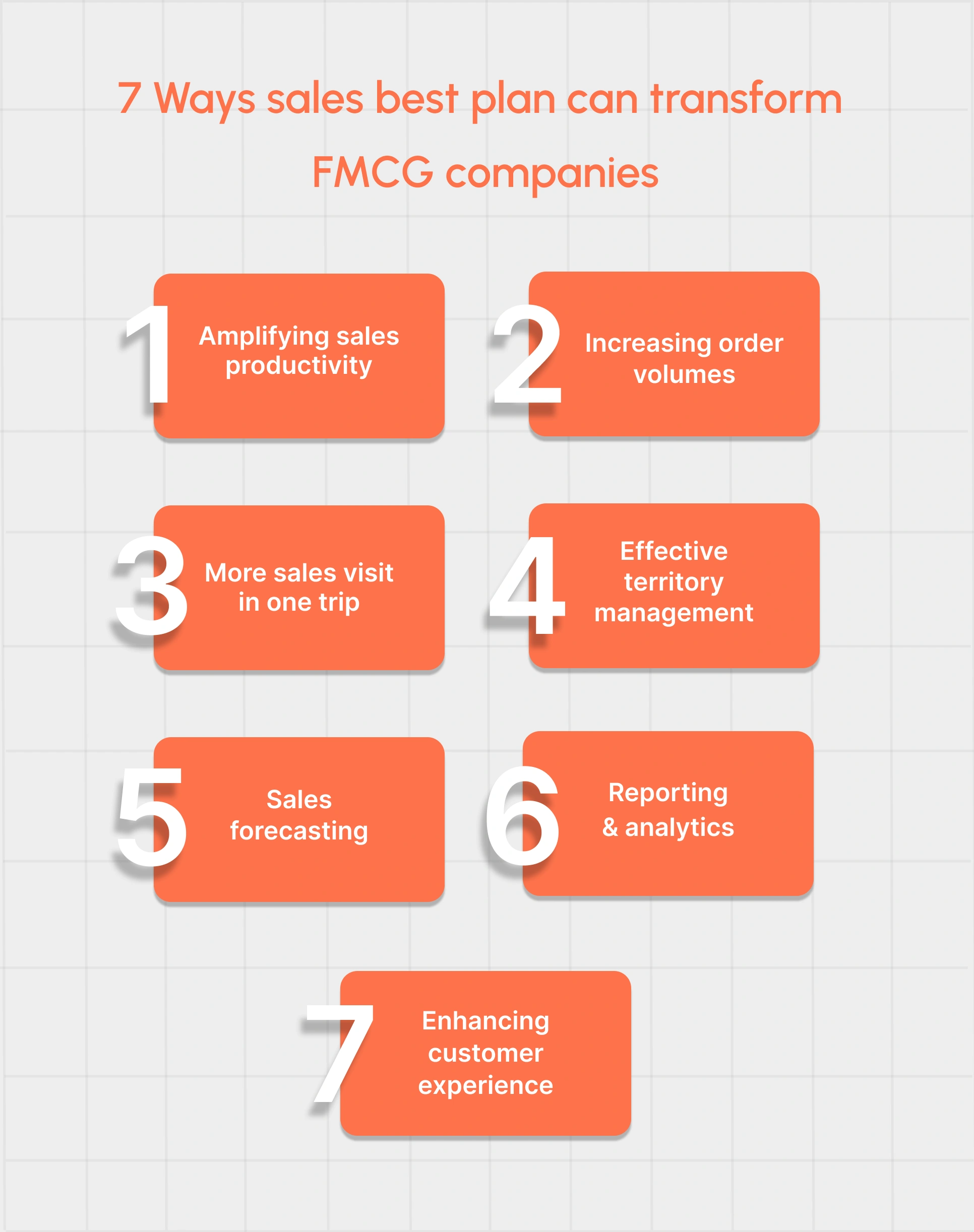
How the Permanent Journey (PMJ) Plan Transforms Sales and Distribution in FMCG
Table of Contents
Why make goals and come often? PJPs help the sales team understand how frequently products have to be restocked and provide them with unique information regarding the people who visit a specific location. Opportunities to engage with clients and learn about their needs and problems are abundant during PJPs. Representatives can instruct store employees on how to handle, arrange, and display products.
Permanent Journey Planning, or PJP, is a crucial aspect of retail and fast-moving customer goods salespeople’s lives. The sales representative’s systematic, prearranged schedule aims to maximize sales and service coverage by visiting retail establishments and client outlets within their territory. The PJP may contain plans to visit particular places, the frequency of those visits, and the visits’ goals.
It is possible to resolve product issues and gather input to provide feedback to the product teams in the corporate office. It is possible to secure new orders in regions where demand is especially high. Of course, the ability to measure and analyze the behavior of competitors is a bonus.

Revenue generation in retail businesses, particularly FMCG, is frequently dependent on a wide range of factors, including having a thorough understanding of omnichannel trends, knowing location demographics, anticipating and meeting customer expectations, and being cautious of the growing market competition. However, timely and efficient delivery of goods to retail locations, where consumers can locate and purchase them as and when needed, is the factor that most significantly influences a company’s expansion, success, and profitability.
What is the need for a Permanent Journey Plan (PJP)?
In the retail sector, distribution refers to the movement of completed items from production plants to the company’s warehouses and/or distribution centers located in different locations. These items are subsequently transported to nearby supermarkets and retail establishments. Distribution is a continuous process, so it is typically handled by a local sales team made up of several sales representatives who are entrusted with understanding market trends, gaining insight into customer demands, and establishing and preserving a friendly relationship with retail outlet owners.
To accomplish this, the sales reps visit each store at a predetermined interval. Along with getting input and other insights from the shopkeepers, they restock the inventory as needed throughout each visit. Permanent Journey Plans, or PJPs for short, are the methods by which sales representatives schedule frequent trips to retail locations for distribution and feedback gathering. A Sales Territory Plan is another name for the Permanent Journey Plan that is frequently used.
Significance of effective sales territory plan
PJP serves as the cornerstone of an efficient distribution system, which is the foundation for the expansion and prosperity of an FMCG company, as we have already wrapped. What parts of the distribution can be enhanced by guaranteeing an effective sales territory plan, then?
The following factors contain the answer:
- Retail stores should not overstock or understock their inventory.
- Each sales team member has a well-defined position.
- The salespeople’s territories are matched to prevent any potential overlap.
PJPs create “virtuous cycles” of interaction between retail locations and sales representatives. Because of this, optimizing PJPs in FMCG and retail supply chains is essential.
| In developed countries like US the market size is US$ seven trillionDeveloping ones like India’s market size is US$ 60 billion. |
What are the difficulties with FMCG and retail sales beat planning?
- Excessive reliance on human intelligence
- Inadequate route planning
- Inaccurate distribution duty assignment
- Insufficient visibility in real-time
Some approaches that retail outsourcing businesses can utilize to carry out this task are listed below:
Territory analysis: Examine the sales teams’ designated areas in detail to learn about the demographics of the customers, their purchasing patterns, and the market potential in each area. When it comes to territory segmentation and prioritizing high-potential locations for expanded coverage, this analysis is helpful. High-potential regions that require special attention include, for instance, places close to upcoming public events and major developments.

Customer segmentation: It is a crucial area that sales teams have historically prioritized and need to keep focus on. Use criteria like sales volume, profitability, potential for growth, and strategic value to divide your clientele. Assign major accounts or high-value clients more frequent visits and resources, while modifying the frequency for customers with lesser priority. As an illustration, whereas mall-based supermarkets might get a lot of foot traffic, standalone supermarkets in outlying locations might do better financially.
Effective planning: Effective planning of the real route sales representatives can help the business save money on labor, fuel, and time. Reduce the amount of time and distance that customers or retailers must travel by streamlining the route planning process. Route optimization software or program variables like traffic, distance, and time limits are useful for route optimization. This kind of route planning could be helpful for locations like several US states that have small cities spread out over vast states.
Optimization of visit frequency: Based on the unique requirements and sales potential of each store, authenticate the ideal frequency of visits for each customer or store. High-value clients might need more frequent visits, depending on the items in issue, whereas low-value clients such as those in remote might need fewer visits. For some products, seasonality—such as Pre Diwali sales—is also taken into account while restocking.
Performance metrics: Determine key performance indicators (KPIs) to gauge the PJP’s efficacy. Metrics to take into account in this situation could include product placement, order value, customer satisfaction, and sales growth. These may shed light on the PJP’s achievements and point out areas in need of development. In many areas of the company, but especially in PJP-related ones, KPIs are a very useful management tool for sales teams.
Constant assessment and adjustment: Sales managers need to conduct frequent reviews and analyses of their representatives’ PJP performance. To find development opportunities, communicate with your team and evaluate the input they have received from clients. Keep the PJP evolving and adapting at a steady pace in response to shifting consumer needs, market conditions, or your organization’s strategic goals. For example, your sales representatives’ PJPs may need to be adjusted when new product lines are introduced or when the stock of outdated product lines is reduced.
Training and development: Educate your salespeople on the ways to visit stores efficiently, interact with customers, know your products, and make sales. Continuous skill improvement will guarantee that PJPs become more efficient. You may maximize sales chances for your product lines and make the most of your sales representatives’ trips. Look for just-in-time training options, such as mobile app-based training and reinforcement learning solutions, to help the sales team, who are “deskless workers” who are constantly on their phones.
Technology-based solutions for PJP optimization are crucial given the complexity and volume of dimensions involved, including reporting and documentation needs, physical locations that are numerous and remote, and other elements like call objectives, routing, and frequency of visits. Mobile apps or software with PJP-focused features, for example, could help salespeople with route planning, customer data collection, real-time inventory data access, and real-time report generation. The sales team’s overall productivity is increased and administrative burdens are lessened with such software.
How does Lystloc help you achieve effective sales and distribution in FMCG?
Effective Permanent Journey Planning (PJP) is essential for retail establishments to manage their inventory, meet changing customer needs, maintain serviceability standards, and boost salespeople’s productivity.
A robust and effective distribution process can be established in the FMCG/retail supply chain through the digitization of PJP and intelligent logistics technology. Platforms like Lystloc streamline and automate the difficult process of sales beat planning. Permanent journey planning, dispatch planning, territory planning, and route optimization are major spans of efficiency and consistency that Lystloc makes possible.
🚀 Long-term travel strategy – In order to efficiently service any retail location, Lystloc determines the right frequency of visits and creates the best plans. On a daily basis, the solution determines the most economical and fuel-efficient distribution routes by taking into consideration a number of business restrictions, including executive skill sets, current traffic circumstances, and customer-preferred time slots.
🚀 Planning for optimal dispatch – In order to ensure optimal vehicle capacity utilization, the system may also identify the best dispatch plan for various retail and consumer goods merchandise categories in the most appropriate delivery fleet. Given their availability and preferred servicing locations, automated dispatch planning also handles allocating the best routes and delivery responsibilities to the appropriate agents.
🚀 Planning of the territory – One essential component of the sales beat strategy is territory segmentation. In order to optimize serviceability and solve the issue of salespeople overlapping in one area, Lystloc makes it possible to accurately map each salesperson to a certain geography or territory. A comprehensive picture of ground operations in every region is also provided by the system, along with performance analysis, prediction alerts, and other insightful information to help with decision-making.
